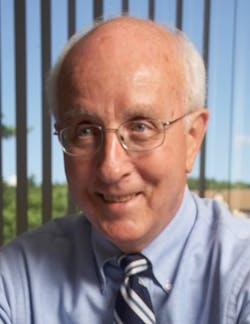Gary Vasilash is a good editor. He knows his readers—essentially those in the auto industry—and he knows the auto-making business, making his writing a pleasure to read. Gary and I are contemporaries; we travel in many of the same circles, meeting often at the same events. He writes informative and entertaining stories based on visits to automotive plants, a talent I admire. Best of all he understands his readers, so he can occasionally be critical, sarcastic and irreverent. I'm glad his publisher apparently recognizes this because he's still editor-in-chief of Automotive Design & Production.
If you're wondering why the big buildup, I'll confess. Gary is a bit of a laser aficionado, although he says, " . . . I have no particular brief for lasers. . ." For many years he has followed the growth of laser materials processing, especially as it relates to auto manufacturing. He rarely misses the annual Automotive Laser Applications Workshop. Although his editorial duties require a broad-brush coverage of all technologies, he manages—whenever possible—to give laser processing a more-than-fair exposure. So he's on my list of favorite people.
In the May issue of AD&P Gary wrote a scathing editorial (titled "Who Cares?"), taking the U.S. auto industry to task for a less-than-enthusiastic use of advanced technology. Readers of ILS have heard me rail about this for 16 years, so a new voice is refreshing. Access AD&P's Website, www.autofieldguide.com, and read his May editorial.
Let me pull some quotes. Comparing positive European experience to that in the U.S., he says, "I am convinced they (lasers) can greatly contribute to the design and production of better vehicles." Countering the U.S. arguments that the technology will be implanted when the financial situation improves, he says, ". . . now is better than later. The competition doesn't wait."
Summarizing what he heard at this year's ALAW meeting he says, ". . . it became extremely evident (my italics) to all the people there that lasers are being widely used in European body shops . . . on vehicles that aren't necessarily exotic, but often bread-and-butter platforms. Meanwhile back in the States, the resistance spot welder still holds sway."
Commenting on what he sees as a prevailing attitude, which he posits is endemic in the U.S. auto industry, he says, this is "A symptom of the lack of implementation of advanced but appropriate (his italics) technology by a whole range of people, whether they are designers, product engineers or process engineers."
This is July, a time I've editorialized on as the lazy, hazy days of summer. A time for relaxing, not deep thinking. However, the slower pace of midsummer also allows time for reflection. If the 16 years of relentless cheerleading I've lead for the use of lasers, especially in the auto industry, haven't sparked some positive response with your management then perhaps the erudite writing of Gary Vasilash will. Make a copy of his editorial and send it to everyone with purchasing authority in your company.
Readers who are not involved with the auto industry may ask why this perpetual beating on the U.S. auto industry. Lord knows we try to be positive. Whenever possible we report positive laser news from the Big Three. We're sitting on a great story right now just waiting for release from Detroit to tell readers about a new body-in-white welding application. It's just that ILS, Gary Vasilash and others are frustrated with the slow pace of laser implementation in the face of proven successes outside the U.S.
About the Author

David Belforte
Contributing Editor
David Belforte (1932-2023) was an internationally recognized authority on industrial laser materials processing and had been actively involved in this technology for more than 50 years. His consulting business, Belforte Associates, served clients interested in advanced manufacturing applications. David held degrees in Chemistry and Production Technology from Northeastern University (Boston, MA). As a researcher, he conducted basic studies in material synthesis for high-temperature applications and held increasingly important positions with companies involved with high-technology materials processing. He co-founded a company that introduced several firsts in advanced welding technology and equipment. David's career in lasers started with the commercialization of the first industrial solid-state laser and a compact CO2 laser for sheet-metal cutting. For several years, he led the development of very high power CO2 lasers for welding and surface treating applications. In addition to consulting, David was the Founder and Editor-in-Chief of Industrial Laser Solutions magazine (1986-2022) and contributed to other laser publications, including Laser Focus World. He retired from Laser Focus World in late June 2022.
